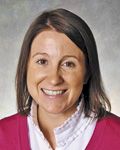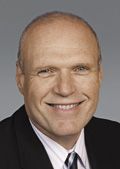The ACO Team
Pharmacists who collaborate with ACOs can find many ways to exercise their skills and expand their knowledge. Partnerships are popping up everywhere, and so are the opportunities.
Accountable care organizations (ACOs) have upped the game for pharmacists as these collaborations demand cost-effective, team care; optimal outcomes; and an emphasis on population health.
Pharmacists are conducting medication therapy management (MTM) and care management services; helping providers and patients make healthcare decisions; and contributing to savings for the ACOs in a variety of settings. Many of the participants are veterans, with histories of many partnerships already under their belts.

Haley HoltanAt Hennepin County Medical Center (HCMC), pharmacists are front and center in all care settings, serving in what Haley Holtan, PharmD, a clinical pharmacist and ambulatory pharmacy services manager for Hennepin, refers to as an “integrated team-based model.”
HCMC, a Minneapolis-based health system with primary care and retail clinics, hospitals and trauma centers, and a broad reach into the community, is in an ideal position to participate in an ACO.
That is exactly what it has done since January 1, 2012, when it created Hennepin Health in consort with Metropolitan Health Plan, an HMO also headquartered in Minneapolis.
“Pharmacists are the medication experts and bring an important skill set to the patient care team,” Holtan said. “They are uniquely positioned to help bridge medication gaps in the transition from hospital to home to the ambulatory care environment. With pharmacists being involved in all phases of care, they are best suited to help ensure safe medication use and help patients achieve their therapeutic outcomes.”
In the hospital, in the home
In the ambulatory clinics, pharmacists assume responsibility for medication reconciliation, resolving adherence problems, and helping patients reach quality goals.
They review each drug-its effectiveness and safety profile, side effects and drug interactions-to ensure it has been prescribed for the right indication; monitor adherence; make changes in dosage if necessary; and educate patients on the importance of taking a specific drug and how it works.
In the hospital setting, pharmacists are assigned to provider teams and accompany physicians on daily rounds and are involved with medication reconciliation upon admission and discharge; however, staffing limitations have made it necessary to stratify patients and concentrate on discharge medication reconciliation for those with more complicated medication regimens and at increased risk for readmission.
Holtan said that an integrated electronic health record throughout the health system, along with continual attention paid to patients, has alleviated some of the medication-related concerns.
But the input of pharmacists does not stop there. They also provide individualized medication management during home visits and at a neighboring transitional care center, where some patients access care for a few weeks after discharge from the hospital to prevent readmission.
Primary care and specialty clinics
HCMC’s dedicated group of pharmacists strives to provide 24 hours of clinical coverage staffing with 26 scheduled shifts daily in the inpatient setting, joined by three pharmacist interns on five-hours shifts to complete medication reconciliation and other duties. On weekends, the number drops to 17 pharmacists, along with the interns.
Anywhere from 10 to 15 pharmacists provide comprehensive MTM and clinical pharmacy services in 15 primary care and specialty clinic locations throughout the health system. In 2006, there were only four pharmacists in attendance.
Pharmacists also play a role in helping HCMC to improve health under the Minnesota Community Measurement, a collaborative initiative promoting public reporting of healthcare information by clinics, medical groups, and hospitals.
Pharmacists have found their groove in the ACO. “Their participation is largely driven by provider requests,” Holtan said. “They no longer have to justify their roles as medication experts to the care team.”
Holtan said, however, that pharmacists still face a few challenges: proving the exact financial impact they have on improved patient outcomes and quality of care and lack of recognition by Medicare as “providers.”
“And if the community pharmacy partners are not within a health system, it may be difficult for them to join in an ACO model,” she said.
This year, HCMC developed a transitions-in-care pilot program, in which pharmacists associated with inpatient general internal medicine split their time between the hospital and clinics to become competent providing care in both settings.
ACO influence grows
Since the enactment of the Affordable Care Act in 2010, more than 360 ACOs have been established and are reaching more than 5.3 million of the 49 million Medicare beneficiaries, according to the U.S. Department of Health and Human Services (HHS).
HHS reported interim financial results for the Medicare Shared Savings Program early this year, indicating that nearly half (54 out of 114) of the ACOs that started program operations in 2012 already had lower expenditures than projected after the first 12 months. Of the 54 ACOs that exceeded their benchmarks in the first 12 months, 29 generated shared savings totaling more than $126 million.
In addition, these ACOs generated a total of $128 million in net savings for the Medicare Trust Fund.
An independent preliminary evaluation of the Pioneer ACO Model -the one designed for more experienced organizations prepared to take on greater financial risk-shows that those ACOs generated gross savings of $147 million in their first year, while continuing to deliver high-quality care.
The Pioneer organizations collectively beat their spending targets by $87.6 million in the first year, $33 million of which went to the Medicare Trust Fund.
Savings from both the Medicare and Pioneer ACOs exceed $380 million.
The role of the care team expands
San Francisco-based Blue Shield of California is no stranger to ACOs; since 2008 the health plan has committed itself to 14 partnerships across the state, four just launched in January. They serve 227,000 members.
Its ACOs include relationships with medical groups-Hill Physicians and Brown & Toland-health systems Dignity Health (formerly Catholic Healthcare West), St. Joseph Health System, and California Pacific Medical Center.

Salina Wong“In the ACOs, our goals are aligned and everyone is engaged and eager to move toward more affordability and quality in healthcare,” said Salina Wong, PharmD, director of clinical pharmacy programs, Blue Shield of California.
The retail setting, where pharmacists deliver MTM services, is the most effective way to “scale” to the population. “Being at a pharmacy allows pharmacists to serve as an extension of the multidisciplinary team and to see patients more frequently,” Wong said.
“That’s a big change from even five years ago; pharmacists are now proactively engaged and do much more than dispensing drugs,” she said.
Pharmacists also play a role in drug adherence, increasing generic use, especially important when biosimilars reach the marketplace, and in medication reconciliation.

Nancy EnglandNancy England, BS Pharm, ACO program manager, senior plans for Blue Shield of California, said that reconciliation is particularly important during transitions of care. Pharmacists are on hand before hospital admittance, work closely with other providers, such as primary care physicians and hospitalists, once patients are discharged-sometimes to a special care clinic before going home-and develop therapy goals.
“In this way, they help prevent 30-day readmissions and eliminate any confusion over medications once patients go home,” England said.
Care teams without pharmacists are clamoring for them, Wong added.
Blue Shield’s first ACO was a pilot collaboration started in 2010 with Dignity Health and Hill Physicians Medical Group, targeting 41,000 California Public Employees’ Retirement System (CalPERS) employees and dependents enrolled in a Blue Shield HMO. In the first two years, the program saved $37 million dollars by reducing readmission rates, average length of stay, unnecessary elective surgeries, and out-of-network services.
The partners beat the 2011 cost of healthcare target by $8 million, which was shared by the partners according to their agreement.
The 30-day readmission rate continued to decline from 4.3% in 2010 to 4.1% in 2011, as reported in the September 2012 issue of Health Affairs.
ACOs incorporate pharmacists
In Blue Shield of California’s ACOs, pharmacists are either employed by the ACO organization as a provider in the clinical setting, or they are on contract and get paid for professional services, such as quality improvement, population management, direct patient care and data analysis, by a medical group, hospital, health plan, or other entity, Wong explained. They share their experience in emergency rooms, hospitals, and in specialty care.
Pharmacists in the ACOs are reimbursed for services, and reimbursement is dependent on the relationship between the pharmacist and the ACO organization.
Wong said that the ACO arrangements include risk contracts around drug management so that pharmacists have “skin in the game,” something that did not happen prior to launching the ACOs. “We as a plan assumed all risk which eliminated any incentives for providers,” Wong said.
In contrast, Cigna’s ACOs may have their own pharmacists participating on care teams, but the more common arrangement is for Cigna and the providers in the ACOs to leverage the expertise of their own pharmacists.

Jay Patel, PharmD, MBA, vice president of clinical pharmacy program development and strategy at Cigna Pharmacy Management, Bloomfield, Conn., said that pharmacists do not receive reimbursement for their contributions through CoachRx, an
online, interactive support service for customers using home delivery, but he anticipates that pharmacists in the retail setting could earn payment for improving adherence and reducing medication side effects.
Aetna does not have pharmacists formally participating in its ACOs, said Jeff Taylor, the insurer’s pharmacy director.
A commentary, “PCMHs, ACOs and Medication Management: Lessons Learned From Early Research Partnerships,” appearing in the Journal of Managed Care Pharmacy February 2014, discusses the two primary ways to incorporate pharmacists and their expertise into ACOs: physician practices employ them directly or an ACO creates a virtual care team model and develops an arrangement with external pharmacists in a community setting to provide coordinated services.

David CalabreseAs ACOs become more mature, said David Calabrese, RPh, MHP, vice president and chief pharmacy officer for Catamaran, a pharmacy benefits manager headquartered in Schaumburg, Ill., there will be greater recognition of what pharmacists can bring to the table and in turn, enable them to be rewarded for their contributions.
Partnerships define insurer
Aetna, headquartered in Hartford, Conn., is well entrenched in the ACO marketplace with participation in 32 partnerships covering more than 550,000 members. Emphasizing a patient-centric, population health management model, the health plan also is engaged in arrangements with patient-centered medical homes, Medicare Advantage, and high-performance networks.
Despite the lack of a formal agreement with pharmacists for participation in an ACO, Taylor said he works closely with partners to support quality goals, such as increasing the use of generics and adherence and ensuring members are receiving medications at the right site of care.
“Since all of our goals are aligned in the ACOs, that helps foster a more cooperative relationship among partners, including between pharmacists and providers,” Taylor said.
“Pharmacists can help medical directors interpret claims data and point to physicians who may need assistance in drug management and apprise providers of our formularies and inform them if patients might be receiving duplicate prescriptions from more than one physician,” he said. “They also can identify patients with chronic disease and try to keep them from ending up in the hospital.”
Agreeing with his colleagues, he emphasizes how important medication reconciliation is for patients discharged from the hospital, who might be taking multiple, new drugs, which can be confusing from theprevious medication regimen prior to hospitalization.
The Aetna Rx Home Success Program pilot, in collaboration with CVS Caremark and Dovetail Health, a healthcare technology company, helps members, who have been recently discharged from a hospital, nursing home, or rehabilitation facility manage their health through personal support from a pharmacist during at-home consultations.
Addressing misuse, waste, and abuse of opioids, Aetna’s programs, comprising limits on how much of a drug is covered at any one time, verification of medical necessity, advising a pharmacist if a drug’s dosage is too high, and review of each new prescription, reduced opioid use by 15% among 4.3 million members between January 2010 and January 2012.
Taylor said that the merger of providers-hospitals and physicians-is opening the door for more involvement by pharmacists.

Brian IsettsBrian Isetts, PhD, BCPS, FAPhA, professor of pharmaceutical care and health systems at the University of Minnesota College of Pharmacy at Minneapolis, agreed with Taylor that more and more physicians are adding pharmacists to their groups to serve in clinics and conduct MTM, including comprehensive medication review, care plan development, and medication reconciliation.
He believes that pharmacists are in the best position to help reduce hospital readmissions, many of which are tied to medication problems.
“When provider organizations deploy pharmacists to provide comprehensive, team-based medication management, it is because they understand how this improves clinical outcomes with reduced per capita expenditures,” Isetts said. “Health systems are losing money when they can’t manage medications.”
Data: Pharmacists dig in
Cigna has 86 collaborative accountable care (CAC) initiatives-a term preferred by the health plan-in 27 states serving more than 880,000 commercial customers and integrating more than 35,000 physicians.
Starting with its first initiative in 2008, Cigna is on target to reach 100 programs with one million customers by the end of 2014.
Patel said Cigna’s ACOs measure their success three ways: 1) ensuring that customers can afford the medications they need, thus decreasing unnecessary visits to the emergency room and hospital admissions; 2) achieving optimal clinical outcomes; and 3) improving the customer experience-all of which Patel said Cigna has accomplished.
Cigna deploys its CoachRx program that identifies customers’ personal barriers to taking their medications and then provides ways to help them stay on track with the medications they need and find alternatives if necessary.
Providers look to Cigna for data on their patients to prevent gaps in care, such as nonadherence.
“Pharmacists are a welcome addition to the ACO team providing optimal therapy and helping us reach performance goals, such as metrics for generic dispensing rates,” Patel said.
Through customer engagement with an embedded care coordinator, some CACs have demonstrated a 52% conversion rate to lower-cost medications, such as generics or lower-cost brand name drugs.
Although the ACOs are running smoothly, Patel points out a major challenge faced by pharmacists: ensuring data is timely. “When it is not, it could prevent them from taking advantage of opportunities to help patients with their therapies,” he said.
Partners and more partners
Health Care Service Corporation (HCSC), the largest customer-owned health insurer in the United States operating through its Blue Cross and Blue Shield Plans in Illinois, Montana, New Mexico, Oklahoma, and Texas, covers almost 14 million lives.
It partners with a variety of health systems in its ACOs, among them, Blue Cross and Blue Shield of Illinois and OSF HealthCare, which has eight hospitals and medical centers, and another with Advocate Health Care, also with hospital and medical centers.
Blue Cross and Blue Shield of Texas and Tenet Healthcare will join forces January 2015 to offer services to BCBSTX PPO commercial patients at any of Tenet’s Texas hospitals through Tenet’s integrated care networks.
Kevin Slavik, PharmD, divisional vice president, enterprise pharmacy operations for HCSC, said the plans’ ACOs go beyond the MTM services offered through Medicare Part D by broadening the criteria for patients; for example, services are available to patients even if they only suffer from one condition rather than multiple ones as outlined by CMS.
Like many of his colleagues, he said ACOs can benefit from the data analysis and reporting skills brought to bear by pharmacists who use the information-health history and pharmacy and medical claims-to identify high-risk patients and to support provider decision-making and development of care plans.
Slavik said that decisions can only be as good as the information supporting them.
One of the major challenges reported in the Journal of Managed Care Pharmacy commentary on lessons learned through ACO early experience is the lack of access to patient information by community pharmacists even though most of them have developed closer relationships with patients than those in integrated health systems.
The article recommends that access could be improved by melding clinical data and claims in an ACO and sharing it with pharmacists in the community setting.
The only downside, however, is the lack of funding that could prevent the addition of pharmacists to provider groups.
Population health equals accountable care
The Montefiore Medical Center has the distinction of achieving the highest financial performance among the 32 Pioneer ACOs and is the only participant in New York State. It saved a total of $24 million in the first year; its share of savings was $14 million, as reported this past January by CMS. Montefiore also spent 7.2% less than its benchmark in the first year, or about $104 a month and reduced admissions due to diabetes by half.
In the Pioneer ACO, Montefiore Medical Center partners with North Shore-LIJ Health System; St. Barnabas Hospital; Morris Heights Health Center, a federally qualified health center; Acacia Network, a social service and primary care agency; and Maimonides Medical Center.

Steve RosenthalStephen Rosenthal, vice president, network management for the New York City-based Montefiore Care Management Organization, said population health management, which the organization has been doing for years, is synonymous with the ACO model.
Besides conducting MTM services, the seven pharmacists on staff at Montefiore play an important role in disease management, ensuring patients stay on their medications at the right dose; work closely with patients at practice sites; and provide financial resources to help patients pay for much needed medications.
Rosenthal said pharmacists serve as “ombudspersons” to resolve issues and anticipates that their roles will evolve into one of care manager with more direct patient interactions.
PBMs could be next
As a pharmacy benefits manager (PBM), Catamaran is carefully exploring how it can work effectively with ACOs, while already providing expertise to plans participating in the new partnerships, whether it be through risk stratification; advanced data analytics to identify and direct patterns of care and ensure the best use of resources; or coordinating pharmacy and medical claims.
“Most of the performance measures under the Shared Savings program are data driven,” Calabrese said. Catamaran also targets nonadherence and conducts MTM services, such as drug review and assessment and preventing medication duplications and adverse events, to help prevent hospital readmissions in its clients’ health plans.
“Pharmacists are critical in driving key performance measures and in identifying high-risk patients, engaging them, and sharing information with providers,” Calabrese said.
“With the groundswell of chronic disease and the emergence of biologics, medications will have even more critical value,” Calabrese said.
Walgreens launched three ACOs in January 2013, applying a team approach to care by leveraging data, evidence-based guidelines, and expanded network of providers to enhance care delivery.
Although pharmacists are not designated as eligible ACO participants by CMS, pharmacies can form relationships with other healthcare providers or provider groups to co-manage their patients and contribute to care collaboration.
“Walgreens pharmacists are fitting into the new model by supporting and collaborating with physicians and coordinating care to help improve health outcomes and prevent hospitalizations and readmissions through adherence programs and other programs/services associated with an ACO,” said Jim Cohn, Walgreens spokesperson.
Community pharmacists oversee MTM, immunizations, medication education and health screenings, along with medication reconciliation, counseling, and bedside medication delivery before ACO patients are discharged from the hospital. Pharmacists then call each patient to follow-up once they have returned home. Cohn said readmissions within 30 days have decreased.
CVS recently expressed its interest in ACOs by saying it plans to contract with ACOs to provide “complementary” primary care-providing pharmacy services with ACOs.
Will drug manufacturers be next?
Support for pharmacist involvement
Providers have embraced the addition of pharmacists on the care teams and look to them for their expertise in drug management, whose time commitment often is a heavy burden for busy physicians, said Salina Wong, director of clinical pharmacy programs, Blue Shield of California.
The enactment of a new California law on January 1, 2014, which grants pharmacists permission to provide clinical advice, offer patient consultation and in some cases, prescribe medications, should help ease the busy workload of physicians and empower pharmacists to become more proactive in their partnerships.
As of December 31, 2012, 41 states plus the District of Columbia authorized pharmacists collaborative drug therapy management or collaborative practice agreements between physicians and pharmacists; however, some of these states have placed limits on practice settings, diseases or conditions, and/or services rendered, according to the Centers for Disease Control and Prevention.
Mari Edlinis a freelance writer in Sonoma, Calif.